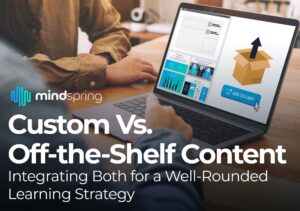The eLearning market is growing, with projected growth reaching $275.10 billion by the year 2022. Business organizations around the world are rushing to implement eLearning for employee training and development, and those who aren’t have (probably) considered it. When you’re in the market for an eLearning module, you’re faced with a decision pretty quickly: buying a premade course, or developing a custom module specific to your organization. Which one’s better? Well, it depends.
Content
When it comes to evaluating the quality of content in an eLearning module, there’s much more to consider than topic and course length. You’re also looking for how the content is being presented, why it’s presented that way, how it’s organized, the tone, the voice… the list goes on. And when it comes down to it, custom eLearning modules can provide better quality content.
That’s not to say that we think the content in premade eLearning modules is bad. Quite the contrary, many contain well written, expert-level content backed by adult learning theory and instructional design best practices. But the thing that premade eLearning can’t offer that custom can is relevance and personalization, and therefore, better learning.
Relevance and personalization go hand in hand. With a custom course, you have the opportunity to create content like role-specific learning, as well as add familiar details like location, real-life scenarios, and even names. This makes the content not only easier to pick up, but also to remember and apply during work every day.
One notable exception, however, is when the content is so generic that specificity would do little to improve the learning experience, such as compliance or outside software training. In these cases, it may not make sense to invest time and resources into creating a custom module, since the course materials will likely not change very much in the context of your organization.
Bottom Line: Custom eLearning modules give you maximum control over content, leading to better learning outcomes.
Time to Implement
In a perfect world, deadlines would always be reasonable and planning would happen well before implementation. Unfortunately that’s not our reality. Sometimes the budget is approved a few weeks before you’re supposed to roll out a new course, or a much-needed purchase falls through, or a million other things could go wrong. When it comes to implementing a new eLearning module fast, premade is the clear winner.
There’s very little contest: on the one hand, you can purchase a module with content, design, knowledge checks, and possibly more all built in, integrate it into your LMS, and get people learning within a few days. On the other, you can create all of that yourself or with the help of an expert partner. No matter how experienced, designing and writing an eLearning course takes time, and if that’s the resource in short supply, a premade course is, at the very least, going to serve as a great bandage.
Bottom Line: If you’re in a major time crunch, premade might be a good choice. If you’ve got even a few months and you’re interested in pursuing a custom module, a partnership with eLearning design experts may be what you need to get across the finish line.
Cost
We keep bringing up cost in our blog because it’s undeniably important in your decision as to which corporate learning solution to pursue. While it’s nice to think of learning as a no-holds-barred business growth initiative, there’s a reason behind every budget. When it comes down to price tags, the number is going to be lower for premade eLearning courses (at least, for comparable topics and depth of content.) But there’s more to it than what you pay upfront.
eLearning creates value for organizations in a variety of ways—check out our blog for a more in-depth look. But what about specifically comparing premade and custom eLearning? While premade eLearning modules can confer some of the same benefits, such as being easily accessible to learners regardless of location, there are others that you can only get with a custom module.
For example, say you find a module with content that works great for your organization. Pretty much everything lines up with your procedures, and you get a good few years of use out of it. But what happens when your procedures change, or the role you were training accumulates new responsibilities and goals? Without the ability to modify the content, you’re faced with the choice of shopping for a new module, or supplementing the old one with material that you have to either create or source. With a custom module, you still have to do some content updates, but it can be more gradual, and more importantly, the entire process is contained within the module. No extra pieces required!
Bottom Line: If you’re looking at just dollar signs, premade modules cost less. When you take value into account, custom wins out.
Design
It’s important not to overlook design when it comes to an eLearning solution. As any instructional designer will tell you, design is about more than making something look nice; it’s also about how people interact with the content, how they perceive it, and how they remember it. Many premade courses are well designed (and if you see one that just looks bad, walk the other way!) but once again, this aspect comes down to control and relevance.
For content related to your organization and how it operates, a branded module that looks and feels like the rest of the content that employees engage with every day will create a more coherent working and learning experience. If you’re training people on how to use Photoshop, however, your company’s branding is probably less important.
Bottom Line: Take the learner’s experience into account. Being able to control the design of your module can help you create a more engaging and memorable eLearning module.
There are fantastic premade eLearning modules out there. There are also custom courses that are, to put it lightly, not great. But done correctly, a custom eLearning module is an investment in your company that will serve you well for years to come. Check out the story behind a custom course we made for Sperry by downloading the case study below.









